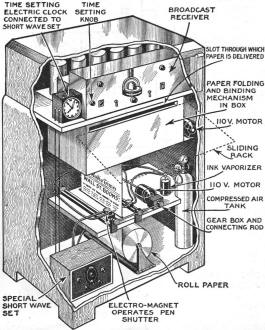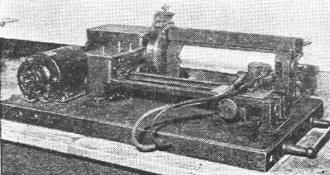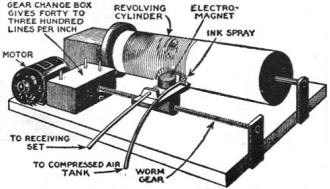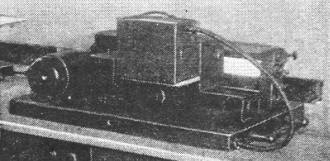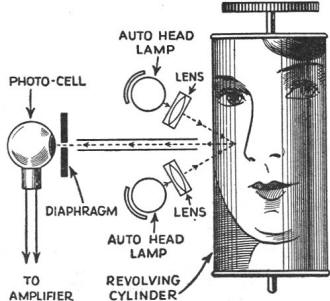Radio Set Prints Newspaper!
|
|
Writing about 'outdated' methods of radio-based facsimile machine implementation in 1934 seems a bit incredible considering how relatively new both technologies were at the time. Nevertheless, Radio-Craft magazine editor Hugo Gernsback reported on the new era of fax machines that were on display at the 1933 World's Fair in Chicago. Of course fax machines of that time were not exactly desktop models that could be located in a corner of your office or cubicle (not that cubicles were common). If you substitute transistors for vacuum tubes, stepper motors for simple DC motors and solenoids, and solid state lasers and LEDs for incandescent light sources, the fundamentals have not changed much. Radio Set Prints Newspaper! There can be no question that the future of radio holds forth the best and most promising inventions - and, amongst those that will probably be seen in the not too for off future - will be a complete newspaper received and printed by the radio receiver, with illustrations, text, and probably advertising. It is even possible to construct such a set now, since equipment in present use for facsimile picture transmission may be readily adapted for a "radio newspaper" unit. These methods and associated equipment and their adaptation ore described in this article. I have frequently observed - the great radio inventions are still to come. So far, the proverbial surface has not been scratched. As the radio technique advances, and we obtain better instrumentalities, it be-comes possible to do a lot of things which have not even been dreamt of before. The radio set of the future has been envisioned many times, but not even the most audacious thinkers, who have projected themselves into the future, have imagined the final radio set - if indeed there is to be such a thing as a final radio set in the dim and distant future. There has been, ever since the advent of radio, a feud between radio broadcasters and the newspapers. Originally, newspapers gave radio a tremendous amount of publicity; but, of late, the newspapers have felt that radio has become their greatest competitor. Consequently, they have cut down a good deal on the space allotted to programs until in many cities, particularly in the Middle West, no free programs are printed at all in the newspapers. These newspapers argue that this is free publicity and, if you wish to have your program printed, the station must pay for it. Indeed, in some of the Middle Western and Southwestern states, this system is now in vogue and the radio stations are indeed paying for their programs. A recorder employed by RCA Communications for picture facsimile reception. The same unit as shown on the left, but in schematic form with explanations of operation. A scanning unit used in the transmission of photographs, by RCA. An ink-pen arrangement that was employed some time ago, but discarded in favor of improved methods. A photo is mounted on a rotating cylinder and scanned, impulses amplified and transmitted. An obsolete method of recording, a solenoid controlled shutter modulates a hot air stream. Recently, a new step was undertaken by the Columbia Broadcasting network to checkmate the newspapers; and Columbia now has its own newsgathering service which extends nationwide and abroad. Every night, a news service is put on the air; the information is, frankly, only "spot" or early, incomplete news; and the network is careful always to have a "by-line" which is as follows: "See tomorrow's paper for complete news." It is believed that in the future the rift between newspapers and radio broadcasters will widen. The idea of using your radio set in your own home, to print a complete tabloid newspaper and deliver it to you, is not original with me. The idea has been mentioned by many well-known radio engineers ever since 1925, and perhaps even before that. There is, therefore, nothing novel in the idea itself; but the project so far, has not been translated into actuality. From the technical standpoint, it is perfectly possible to build, today, a radio set, for use in your own home, which will deliver to you, early in the morning, a small newspaper, and do this regularly, every day in the week. So far, the only drawback has been, in my estimation, the price. Such a set is expensive to build, and somewhat complicated and costly. If, however, the country wants a Radio-Newspaper Receiving Set, the radio industry is, no doubt, in a position to furnish such a set on short order. Indeed, I will be considerably surprised if such sets are not on the market within the next five years. While none of these sets have, as yet, been built, I have outlined in these pages the technical details of bringing it about; and, though the system which I show here may not be the only practical one, I have selected it because a similar method is now in use by the Radio Corporation of America in their picture-transmitting devices which are in operation twenty-four hours a day throughout the week. Let us now see what the future radio newspaper set will look like: As our cover illustration shows, it seems very much like any other radio set, but with certain attachments. These are, chiefly, a panel which pulls out, and upon which, in the rack provided, you will find a newspaper ready and printed in the morning. Remember, too, this will not be a bulky 64-page newspaper! it will be, probably, a 4- or 8-page tabloid, giving you condensed news and pictures of the important events, similar to that shown in the cover illustration. The cabinet contains the usual broadcast and short-wave set, as we have them today. In addition to this, there is a separate special short-wave set, to take care of the reception of the news, and which will be described later. The set also contains a clock which is set for, let us say, 2 A.M. At this time, the clock disconnects the broadcast set from its aerial and ground and in its stead, switches on the special short-wave set; and, at the same moment, the electric motor (which has to do most of the work in printing the newspaper) is also placed into the circuit. A few seconds later the radio signal impulses begin to come over the special short-wave set, and the newspaper is now being "printed." In the particular method which is shown here, for the first time, there is no "printing" being done as we know "letterpress" printing today; it is all done by a special method, both sides of the paper being acted upon at the same time. I will explain details further on. The electric motor, which feeds the newspaper roll, advances the roll little by little until, in an hour or less, the entire newspaper is printed. When it is finished, the paper is folded by an automatic folding attachment, and the newspaper, still moist, drops into the holder out of the set. No matter how early you rise in the morning, you will find your newspaper ready and waiting for you. The expense of the newspaper, it may, be stated, is very slight. The paper, chemicals and the electricity consumed in manufacturing the newspaper only amount to a few cents - much less than it costs to produce a standard newspaper today. The question arises immediately, why should the broadcasters set in motion their transmitting machinery, as well as their news-gathering agency, the collecting of "spot" photographs of current events, etc.? The answer is that it will pay them to do so. They will probably accept a limited amount of advertisements and, if they obtain a sufficient amount of these, the enterprise can be made to pay for itself. Remember that, of course, we are speaking of the future when, we premise, there will be several millions of these sets in use. The advertising revenue from such a large circulation will be quite heavy, and the broadcasters will, no doubt, be able to get a sufficient amount to make it worth their while. As to technical details, let me first state that, whatever I have said here, comes strictly within present-day radio technique. The apparatus which I illustrate is simply an adaptation of that now in use by RCA, and open to public traffic at the present. The original apparatus now used was devised by Capt. R. H. Ranger, formerly research engineer with RCA. The receiver, or picture reproducer, during the past few years, has gone through a number of changes. At one time an ink-pen arrangement was used with a special waxed paper. Later on, a jet of hot air was used, the force of the jet being modulated or varied in accordance with the light and dark parts of the picture, all by means of an electromagnetically operated valve, built into the air jet. The chemically-prepared paper, on which the image was reproduced, was wrapped around a cylinder, driven by a specially synchronized motor rotated in perfect step or synchronization with a similar cylinder containing the original picture at the transmitting station. The hot jet air apparatus has been abandoned in favor of the present ink-vapor jet, which is now being used; since it gives better details than the former hot-air jet. We recently saw pictures, measuring 8 1/2 x 12 ins., being recorded on a 21 meter wavelength transmitted over 2,500 miles (from San Francisco). The same apparatus is used to handle commercial orders for pictures, received from Europe, on short waves day or night; the day wavelength being about 21 meters and that for night 30 meters or more, depending upon atmospheric conditions. At the transmitting end, the photograph is rotated on a cylinder which is kept in perfect synchronization by special synchronizing means, including a temperature controlled tuning fork and a powerful concentrated pencil of light; the latter scans the photograph, line by line, as the cylinder on which it is mounted rotates in front of a pair of concentrated-filament headlight bulbs and a pair of lenses. The light reflected from the photograph being scanned passes through a small black tube and a diaphragm, into a photoelectric cell connected in a special bridge circuit. Before the photoelectric cell's impulses are sent over the line or by radio waves to the receiver there is imposed on the "image signal" a special accurately-timed interruption signal which has the effect of breaking up the dots constituting the image at the receiver, and serves to produce the well-known halftone effect. In some picture-facsimile systems the width of the line is modulated; but in the RCA system the length of the dots is changed in accordance with the highlights and shadows of the image being transmitted, and as previously mentioned, the dots are furthermore split up into fractional dots so as to get a better halftone effect, as has been found to be the case in practice.
Posted September 14, 2020 |
|
 [
[